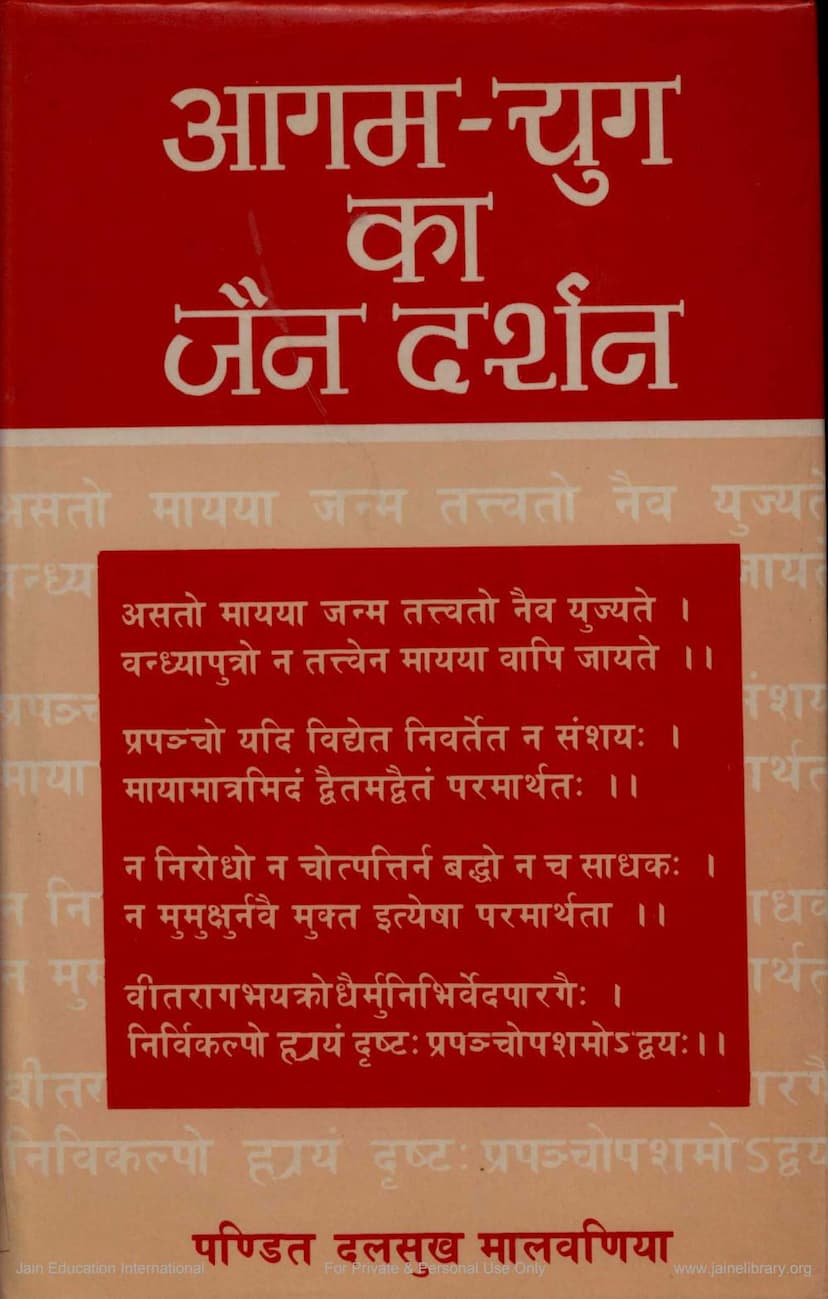Agam Yugka Jaindarshan
Added to library: September 1, 2025

Summary
Here's a comprehensive summary of the Jain text "Agam Yugka Jaindarshan" by Dalsukh Malvania, based on the provided pages:
Book Title: Agam Yugka Jaindarshan (Jain Philosophy of the Agamic Age) Author: Pandit Dalsukh Malvania Publisher: Prakrit Bharti Academy, Jaipur Catalog Link: https://jainqq.org/explore/001049/1
Core Focus and Significance:
This book, "Agam Yugka Jaindarshan," by the renowned Jain scholar Dalsukh Malvania, is presented as a pioneering work that specifically addresses the Jain philosophy during the "Agamic Age." The author emphasizes that while considerable scholarly attention has been given to Jainism a thousand years after Lord Mahavir, and to the period after that, there has been a notable gap in understanding the development of Jain philosophy during the first thousand years after Lord Mahavir. This book aims to fill that void for the first time.
Key Content and Themes:
The book is structured to provide a comprehensive overview of Jain philosophy from its foundational texts to its early development. Its key contents and themes include:
- Introduction to Agam Literature: The initial chapters offer an overview of Agam literature, its preservation, the challenges faced in its transmission (such as the Pataliputra and Valabhi councils), and the composition periods of various Jain scriptures.
- Philosophical Precursors: The author provides a brief overview of philosophical discussions from the Vedic period up to the Upanishads. This serves as a contextual backdrop for understanding the evolution of Indian philosophical thought.
- Comparison with Buddhism: The book delves into the distinctions between Lord Mahavir's and Lord Buddha's philosophical perspectives. It explores how Lord Mahavir addressed the "unexplained questions" (avyakrta prashna) posed by Lord Buddha and elaborates on the establishment of Anekantavada (the doctrine of non-absolutism or manifold aspects) by Mahavir.
- Core Jain Philosophical Concepts: The work provides an in-depth analysis of fundamental Jain ontological (prameya) and epistemological (pramana) principles as found in the Agamas.
- Prameya (Ontology/Categories of Reality): This section discusses the Jain view of reality, including the nature of substance (dravya), attributes (guna), and modes (paryaya), and their interrelationships. It examines the concept of satt (being) and the ancient roots of Jain metaphysical thought.
- Pramana (Epistemology/Means of Valid Knowledge): This part offers a detailed discussion on Jain epistemology, particularly pratyaksha (direct perception) and anumana (inference). It analyzes the classification of knowledge and the Jain approach to perception, inference, comparison (aupamya), and testimony (agama).
- Anekantavada and Syadvada: The book offers a detailed discussion on Anekantavada (non-absolutism) and its logical extension, Syadvada (the doctrine of conditional predication), and the Saptabhangi (the sevenfold judgment). It highlights how Mahavir's philosophy offered a solution to the dialectical challenges of his time, particularly addressing the "unexplained questions" that even Buddha found difficult to answer definitively. The text explores the historical development of these concepts, tracing their roots and evolution.
- Debate and Logic (Vada and Vadavidya): A significant portion of the book is dedicated to the principles of debate and argumentation (vada) as understood within the Jain tradition, particularly in relation to dialectical methods and logical fallacies (vada dosha). This section highlights the importance of intellectual discourse in Jain philosophy.
- Post-Agamic Jain Philosophy: The final chapters explore the contributions of post-Agamic scholars like Vacaka Umasvati, Acharya Kundakunda, and Siddhasena, examining their interpretations and elaborations on prameya, pramana, and Syadvada. It highlights their foundational role in shaping the later development of Jain philosophy.
- Appendices: The book includes three appendices that further enrich the reader's understanding:
- The evolutionary sequence of philosophical literature.
- An analysis of Acharya Mallavadi and his significant work, the Nayas-chakra.
- A detailed index of names and terms.
Key Philosophical Contributions Highlighted:
- Anekantavada and Syadvada: The book underscores Mahavir's pivotal role in establishing Anekantavada as a central philosophical tenet, offering a sophisticated framework for understanding reality from multiple perspectives.
- The Nature of Reality: It discusses the Jain understanding of dravya (substance), its inherent permanence, and the ever-changing paryayas (modes), emphasizing their inseparable relationship.
- Epistemology: The book clarifies the Jain approach to knowledge, distinguishing between direct (pratyaksha) and indirect (paroksha) perception, and critically examining the role of senses and the mind.
- Debate and Logic: It showcases the sophisticated logical tools and debate strategies employed in Jain discourse.
- Historical Context: By situating Jain philosophy within the broader Indian philosophical landscape, the author highlights the intellectual milieu in which Jainism flourished and how it responded to contemporary debates, particularly with Vedic and Buddhist thought.
Overall Purpose:
"Agam Yugka Jaindarshan" is an academic and comprehensive study intended for serious students and scholars of Jain philosophy. It aims to provide a foundational understanding of Jain thought as it developed within the Agamic period, demonstrating its intellectual rigor and its sophisticated engagement with other philosophical systems of ancient India. The book emphasizes the originality and systematic development of Jain philosophical doctrines during this crucial era.